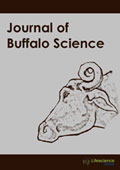jbs
Abstract : Modernizing Buffalo Production in Iran: A Postmodern Essentiality
|
|
|
|
Abstract : Feasibility of Artificial Insemination Network for Egyptian Buffalo Development
|
|
Abstract: Reviews of literature confirmed that Egypt has a comparative advantage in milk production rather than red meat, particularly from buffalo. In addition, there is an increasing scarcity in water resources, which constrains horizontal expansion in fodder acreage. In addition, there is a sharp competition between food demand and feed demand on available agricultural land resources. Thereof, a horizontal expansion in dairy buffalo stock would not be feasible. Thereof, the only option for buffalo development in Egypt is the vertical expansion via increasing milk yield to fulfil the current deficit in domestic milk production. The Egyptian consumer gives high preference to buffalo milk for color taste and high content of total solids, particularly fat. Buffalo milk has higher price than cow milk and its production grow faster than cow milk production. Artificial insemination (AI) network is the approach to accelerate the proposed genetic improvement of the buffalo milk yield. A recent study [1], provided evidence that the return of genetic investment in dairy buffalo would be feasible, (IRR = 19.71%) However, the Official statistics showed that there are only two AI-centers for buffalo selected buffalo sires, serving four AI-units in Egypt. Therefrom, the objective of this study was to assess the feasibility of establishment an AI-network in Egypt, by estimating (NPV, IRR, and payback period) and its sensitivity to unfavorite changes that may face the proposed program. The study used a field survey data collected from an AI-unit of the buffaloes’ semen and an AI-Center for raising buffalo sires in Nile Delta. Results showed that, while the average discount rate of the Egyptian economy was 17.5%, under the most probable condition the estimated IRR for one AI-unit was about 35%. A 10% Decrease in Semen Price and a 10% increase in Insemination Costs would result in IRR about 28% and 31%, respectively. The estimated IRR for the AI-center, under the most probable conditions was about 31%. 10% Decrease in Semen Price, and 10% increase in feed costs or in Sire’s price would result in 26%, 30% or 28% respectively. Thereof, the less sale price of semen dose is the most effective variable on the IRR. However, unfavorable changes would keep investments with high incentives in establishing a feasible AI-Network for increasingly rapidly the dairy buffalo milk yield. Keywords: Buffalo, AI, NPV, IRR. |
Abstract : Characterization of Buffalo Dairy Production Systems in Egypt Using Cluster Analysis Procedure
|
|
Abstract: The study objective was to characterize and classify buffalo dairy production systems in Egypt. Ten governorates having high buffalo population density were selected as the study area. The data were collected from 1811 dairy buffalo farms using survey. Buffalo holders were face to face interviewed by constructed questionnaire. The survey was applied in two years (2010 and 2011). Two-Step Cluster procedure (CA) was used and analysis was repeated several times until the cluster quality came good (average silhouette ≥0.5). The algorithm selected the number of clusters, after calculating the Akaike’s information criterion (AIC). Statistics of CA showed that the numbers of farm in each cluster were 43 (2.4%) in cluster1 (CL1), 1364 (75.3%) in cluster2 (CL2) and 404 (22.3%) in cluster3 (CL3). CL1 farms had a good availability of facilities. The management practices were the higher in comparison with the farms in the other clusters. Management and feeding systems practices in CL1 ranged from medium to high. CL2 was the largest, with 1364 farms located in all the ten governorates. The availability of facilities and equipment were low or lacking. The management practices were the lowest in comparison with farms in other clusters. CL3 facilities availability were low to medium. The management practices were medium when compared with the farms in the other clusters. The results of the current study demonstrate the existence of a large variability among buffalo dairy production systems in Egypt. These systems variability should be taken into consideration for sustainable system development. Keywords: Buffalo, production systems, typology, characterization. |
Abstract : Circadian Patterns of Ingestion and Rumination in Ruminants: A Chronophysiological Review
|
|
Abstract: Grazing occurs mainly around sunrise and sunset. The time spent eating during the dusk grazing bout appears to be longer than that during the dawn and afternoon bouts. The rumen fill has likely a more significant role in regulating the dusk feed intake compared to dawn and afternoon feed intakes. The evening instead of morning feed delivery in once daily fed lactating dairy cows has increased eating rate and the amount of feed ingested within 3-h post-feeding substantively. Evidently, feeding strategies and systems regulate feed intake through altering circadian rhythms of feed intake in high-producing ruminants. The large evening meals in grazing cows have partly been linked to an optimal foraging strategy. Ruminants attempt to optimize their nutrient intake profile by filling the rumen in the evening because usually little grazing occurs overnight. Turning lights on and off seems to act as an inducer, thus stimulating eating activity. Dairy cows fed once daily at 2100 vs. 0900 h have experienced a larger rumen volume. The greater rumen contents or greater rumen fiber load may stimulate bolus formation required for rumination. The greater rumen contents or greater rumen fiber load may stimulate bolus formation required for rumination. Future research is warranted to quantify how different managements can manipulate eating and ruminating patterns in dairy and beef ruminants undergoing varying physiological states. Keywords: Feed, Ingestion, Rumination, Circadian pattern, Rhythm. |






















